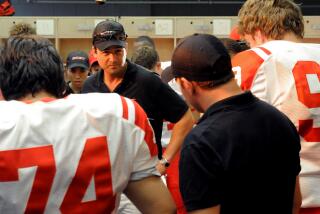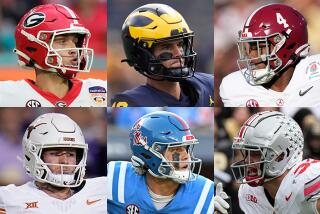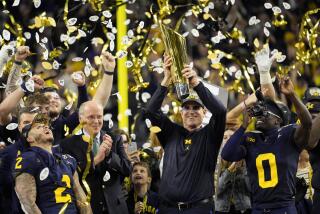This One Has a Familiar Ring to It
NEW ORLEANS — No ringing in the new in these parts.
If anything, the 1998 Sugar Bowl was more like a return to the past after the aberrations that were Ohio State’s Rose Bowl victory and Florida State’s loss here a year ago.
Florida State’s 31-14 victory in the Superdome on Thursday night got the fourth-ranked Seminoles back to their bowl-winning ways, atoning for the loss to Florida a year ago that ended an 11-game winning streak in bowl games.
“Now we’re 12 out of 13,” Florida State Coach Bobby Bowden said. “That feels a little bit better.”
Ohio State fell to 2-7 in bowl games under Coach John Cooper, an ugly companion statistic to his 1-8-1 record against archrival Michigan. Maybe that’s why Bowden didn’t seem offended when Cooper said, “We’re going to kick their [butt]” at a pep rally earlier this week. It was like the ramblings of an independent candidate in a presidential campaign. They might say bold and brash things, but are they ever a factor on election day?
Thursday, the ninth-ranked Buckeyes (10-3) were done in by their inability to match the big plays of Florida State (11-1), their inability to put the ball in the end zone and a trick play attempt in the first half that backfired.
“We gave up more big plays in the game tonight than I guess we have all year long,” Cooper said.
With the victory, Florida State will finish in the top four of the Associated Press rankings for the 11th straight year.
Coming into the game, Bowden held out a slim hope that his Seminoles could be voted national champions if they beat the ninth-ranked Buckeyes, Washington State beat top-ranked Michigan in the Rose Bowl and No. 2 Nebraska and No. 3 Tennessee played to “the sorriest tie you’ve ever seen” in the Orange Bowl today.
Michigan’s win in the Rose Bowl ended that possibility.
But even Bowden knew it was an unlikely scenario regardless of the Rose Bowl outcome, and the fans didn’t buy it either. The attendance of 67,289 was the lowest in the 23 years the game has been played in the Superdome.
Whatever interest there was in this game came from the matchup of two of the most talented programs in college football. Ohio State has produced 12 first-round NFL draft picks in the 1990s and Florida State has sent 11 first-rounders to the NFL, with more sure to come in the next few years.
Florida State wide receiver E.G. Green might not be on the top of most scouts’ lists, but he was the star attraction Thursday with seven receptions for 176 yards and a touchdown to earn the outstanding player award.
In addition to his 27-yard touchdown catch, Green had a 46-yard reception that led to Florida State’s second touchdown and a 42-yard pass play that took some of the momentum away from Ohio State after the Buckeyes pulled within 10 points in the fourth quarter.
“If you hear Michael Jordan say, ‘I got in a zone and the basket was so big I could not miss’, that’s the way I felt out there,” Green said.
Running back Travis Minor, who came from the same Baton Rouge, La., school that produced Warrick Dunn, had nine receptions for 55 yards in addition to 53 rushing.
In the first half, there were nine punts, 13 penalties and passes dropped all over.
Joe Germaine, supposedly the classic passer in Ohio State’s two-quarterback rotation, threw two interceptions in the first half. The second was returned 51 yards by Shevin Smith, leading to a one-yard touchdown run by William McCray that put Florida State ahead 21-3 just before halftime.
Florida State quarterback Thad Busby’s first-quarter numbers of 10 completions in 12 attempts sounded good, but the incomplete passes were interceptions. He finished 22 of 33 for 334 yards.
When the Buckeyes tried to get sneaky, they paid dearly. On the first drive of the second quarter, Ohio State lined up in field goal formation on fourth down from the Florida State five. Instead, holder Brent Bartholomew threw to John Lumpkin, who crept onto the field at the last second and was uncovered by the Seminoles.
Instead of a touchdown, Ohio State was penalized 15 yards for unsportsmanlike conduct because Lumpkin was not between the hash marks on the field when the 25-second play clock started.
“We thought we had it set up,” Cooper said. “I covered that to the best of my ability with the officials before the game. I thought we executed the play the way we told them we were going to.
“I was not under the impression that you had to be lined up inside when the ball is marked ready to play. Obviously, that’s a big play in the ballgame, but it did not cost us the game.”
More to Read
Go beyond the scoreboard
Get the latest on L.A.'s teams in the daily Sports Report newsletter.
You may occasionally receive promotional content from the Los Angeles Times.










